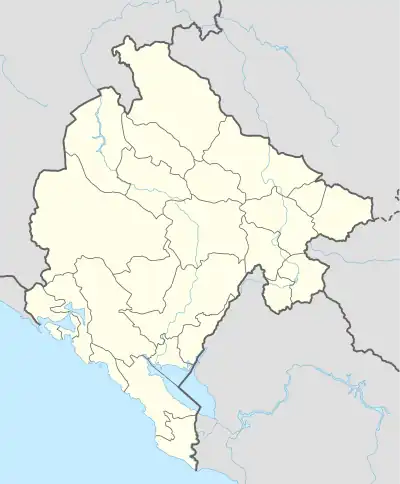Koći
Коћи Kojë | |
|---|---|
Village | |
 Koći Location within Montenegro | |
| Coordinates: 42°27′38″N 19°24′13″E / 42.46056°N 19.40361°E | |
| Country | |
| Municipality | |
| Population (2011) | |
| • Total | 54 |
| Time zone | UTC+1 (CET) |
| • Summer (DST) | UTC+2 (CEST) |
| Area code | +382 20 |
| Car plates | PG |
Koći (Cyrillic: Коћи; Albanian: Kojë) is a village in the municipality of Tuzi, Montenegro, near the border with Albania. The village is inhabited by ethnic Albanians of the Roman Catholic faith.
Geography
Koći lies east of the capital Podgorica, north of Ubli. Koći is a village in Koja e Kuçit, eastern Montenegro, bordering Albania.
Along with Albanian-inhabited Hoti and Gruda, Koći is, from Albanian point of view, part of the wider Malësia-region (Malesija).[1]
History
At the beginning of the Montenegrin–Ottoman War, the Kuči rose up against the Ottomans, who started dispatching soldiers at the frontier, including at Koći.[2]
According to Spiridon Gopčević, the area of Koći included 10 km2 and 550 inhabitants, out of which 480 were Catholics, 40 Orthodox, and 25 Muslims (1877).[3]
20th century
Traveler Arso Milatović (who wrote a travel book on his experiences 1935–45) stayed at Koći and described it as "a village neighbouring Malesia, misplaced and rugged, which a horse can't reach, thus donkeys and mules walk the rocks as squirrels on branches".[4] The inhabitants were Catholics, and the village had a church and priest, fra Marko.[4] A church was built by the ethnic Albanian migrant workers who left the village for Europe in the period of 1964–74.[5] The village population has since massively decreased.[5]
| Ethnic group | 1948 | 1953 | 1961[6] | 1971[7] | 1981[8] | 1991 | 2003[9] | 2011[10] |
|---|---|---|---|---|---|---|---|---|
| Albanians | 411 | 501 | 301 | 73 | 48 | |||
| Montenegrins | 35 | 19 | 77 | 8 | ||||
| Yugoslavs | 15 | 4 | ||||||
| Undeclared/ Others |
1 | 4 | 6 | |||||
| Total | 416[11] | 471[11] | 446 | 536 | 386 | 237[11] | 91 | 54 |
Culture
Some Albanian Catholics have the custom of family and tribe celebration of saints (called festa in Peja), as is found in the Serbian Orthodox tradition of krsna slava.[12]
Notable people
- Pretash Zekaj Ulaj (1882-1962), commander in the Battle of Deçiq against the Ottoman Empire.
References
- ↑ Recherches albanologiques: Folklore et ethnologie (in French). Pristina: Instituti Albanologijik i Prishtinës. 1982.
- ↑ Miljanov, Marko (1990). Čađenović, Jovan; Zuković, Ljubomir (eds.). Primjeri čojstva i junaštva; Život i običaji Arbanasa; Fragmenti; Pisma; Bibliografija. Crnogorska akademija nauka i umjetnosti. ISBN 9788672150179.
У почетак рата, ја сам доша у Куче, у турску границу, те су се поб- унили Кучи и обрнули пушку на Турке. Паша турски је потпу- нио с војском Медун и фортице, Фундину, Коће, Затријебач и Ора'ово. У Ора'ово је метнуо Арбанасе, ...
- ↑ S. Gopevi. Das F?rstentum Albanien. Рипол Классик. pp. 59, 62, 193. ISBN 978-5-87453-346-5.
- 1 2 Arso Milatović (1990). Kosmet: 1935-1945: moje svedočenje (in Serbian). Naučna knjiga. p. 19. ISBN 9788623700859.
- 1 2 Momčilo S. Lutovac (1980). Migracija radne snage iz Crne Gore na privremeni rad u inostranstvu: (1964-1974) (in Serbian). Srpsko geografsko društvo. p. 132.
- ↑ "popis 1961" (PDF). p. 140. Archived from the original (PDF) on 2013-12-20.
- ↑ "popis 1971" (PDF). p. 126. Archived from the original (PDF) on 2016-03-04.
- ↑ "popis 1981" (PDF). p. 155. Archived from the original (PDF) on 2016-03-04.
- ↑ Књига 1, Становништво, национална или етничка припадност, подаци по насељима, Републички завод за статистику, Подгорица, септембар 2004, ISBN 86-84433-00-9
- ↑ "Table N1. Population by etnicity by settlement". Census 2011 Data - Settlements. MONSTAT.
- 1 2 3 Tim Bespyatov, ed. (2008–2013). "Montenegro censuses 1948-2003". (note: no data on ethnic groups, language and religion, only total population)
- ↑ Srpska akademija nauka (1957). Bulletin of the Ethnographical Institute (in Serbian). Vol. 4–6. Naucno delo. p. 366.
О називу обичаја и врсшама „фесше" Славу, породичну и племенску Шиптари у околини Пећи називају феста, ... Говорећи о слави код Арбанаса, 1) Исто помиње и Ј. Ердељановић у нав. делу 299, где каже да „Коћи славе св.
Sources
- Erdeljanović, Jovan (1907). Kuči - pleme u Crnoj Gori (in Serbian).
External links
- Maplandia. "Koci Map — Satellite Images of Koci".